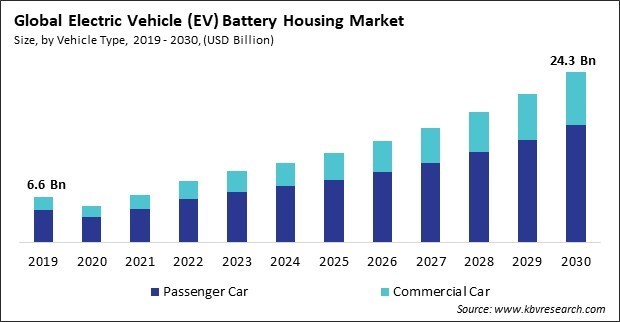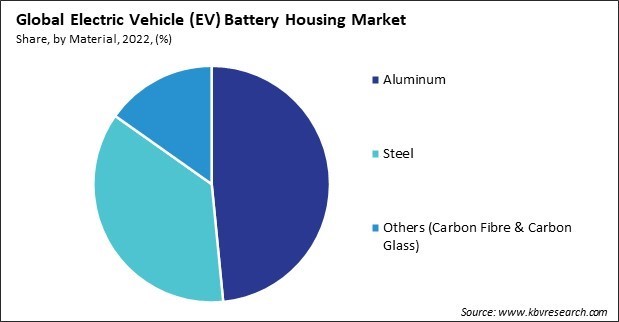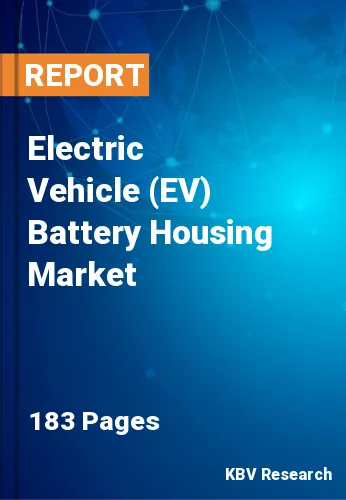“Global Electric Vehicle (EV) Battery Housing Market to reach a market value of USD 24.3 Billion by 2030 growing at a CAGR of 13.2%”
The Global Electric Vehicle (EV) Battery Housing Market size is expected to reach $24.3 billion by 2030, rising at a market growth of 13.2% CAGR during the forecast period.
North America has seen tremendous investment in charging networks, making it easier for EV owners to charge their vehicles and lowering range anxiety. Therefore, the North America region captured $1,847.3 million revenue in the market in 2022. Consumers in North America are increasingly recognizing the environmental benefits of EVs, including reduced greenhouse gas emissions and decreased dependence on fossil fuels. Urban areas in North America are increasingly adopting clean air initiatives and sustainable urban planning.

The expansion of charging infrastructure is a key driver for the growth of electric vehicles. The availability of convenient and widespread charging stations encourages consumers to adopt electric vehicles, driving the demand for efficient and reliable EV battery housing. A well-developed charging infrastructure alleviates range anxiety, a common concern among potential electric vehicle buyers. Additionally, in battery housing, lightweight materials, such as aluminum and high-strength alloys, contribute to overall vehicle efficiency. Weight reduction is critical for electric vehicles to enhance range and energy efficiency, driving the adoption of advanced lightweight materials in EV battery housing. Lightweight materials often possess favorable characteristics in terms of energy density. Lightweight materials are often integrated into the overall chassis design of electric vehicles. This integration enhances the vehicle's structural strength, rigidity, and stability. The seamless integration of lightweight materials with the vehicle chassis positively influences the handling and performance of the electric vehicle. Thus, advancements in lightweight materials have been a pivotal factor in driving the growth of the market.
However, Stringent regulatory compliance may result in a more cautious approach to innovation and development. Manufacturers may prioritize meeting existing standards over pursuing groundbreaking advancements, potentially slowing down the pace of innovation in EV battery housing technologies. Meeting stringent regulatory standards often involves additional testing, certification, and compliance processes, contributing to increased costs. The time-consuming nature of certification processes and the need for extensive testing can delay the introduction of new models and technologies to the market. Strict regulatory requirements can create barriers to entry for smaller manufacturers or new entrants to the electric vehicle. Smaller businesses struggle to compete with established companies due to the financial and technical resources essential to navigate complicated compliance processes. Hence, regulatory compliance and standards can hamper’s the growth of market.
Based on material, the market is classified into steel, aluminum, and others (carbon fibre & carbon glass). In 2022, the aluminum segment witnessed the largest revenue share in the market. Aluminum is known for its low density and high strength-to-weight ratio. Aluminum has excellent thermal conductivity, allowing for efficient heat dissipation. In EVs, efficient thermal management is crucial for maintaining optimal battery performance. Aluminum components in battery housing facilitate the dissipation of heat generated during charging and discharging, contributing to battery longevity.

By vehicle type, the market is categorized into passenger car and commercial car. The commercial car segment covered a considerable revenue share in the market in 2022. Commercial fleets, such as delivery vans and trucks, often involve large-scale purchases. Adopting electric commercial vehicles leads to significant orders for EV battery housing components. Adopting electric commercial vehicles enhances businesses' public image and commitment to corporate social responsibility. Many consumers and clients value businesses that prioritize sustainability and environmentally friendly practices, creating a positive association with companies using electric vehicles and advanced battery housing.
Free Valuable Insights: Global Electric Vehicle (EV) Battery Housing Market size to reach USD 24.3 Billion by 2030
Region-wise, the market is analysed across North America, Europe, Asia Pacific, and LAMEA. In 2022, the Asia Pacific region led the market by generating the highest revenue share. The rapid urbanization in many Asian cities has increased concerns about air quality and pollution. The Asia Pacific region is a hub for technological innovation and manufacturing expertise. As a result of their leading position in developing advanced battery technologies and manufacturing capabilities, China, Japan, and South Korea have significantly contributed to the growth of electric vehicle (EV) battery housing.
| Report Attribute | Details |
|---|---|
| Market size value in 2022 | USD 8.9 Billion |
| Market size forecast in 2030 | USD 24.3 Billion |
| Base Year | 2022 |
| Historical Period | 2019 to 2021 |
| Forecast Period | 2023 to 2030 |
| Revenue Growth Rate | CAGR of 13.2% from 2023 to 2030 |
| Number of Pages | 183 |
| Number of Tables | 250 |
| Report coverage | Market Trends, Revenue Estimation and Forecast, Segmentation Analysis, Regional and Country Breakdown, Porter’s 5 Forces Analysis, Company Profiling, Companies Strategic Developments, SWOT Analysis, Winning Imperatives |
| Segments covered | Vehicle Type, Material, Region |
| Country scope |
|
| Companies Included | Magna International, Inc., Proterial, Ltd., Saudi Basic Industries Corporation (SABIC), Lanxess AG, Evonik Industries AG, Covestro AG, Teijin Limited, thyssenkrupp AG, SGL Carbon SE and Constellium SE |
By Vehicle Type
By Material
By Geography
The Market size is projected to reach USD $24.3 billion by 2030.
Charging infrastructure development are driving the Market in coming years, however, Regulatory compliance and standards restraints the growth of the Market.
Magna International, Inc., Proterial, Ltd., Saudi Basic Industries Corporation (SABIC), Lanxess AG, Evonik Industries AG, Covestro AG, Teijin Limited, thyssenkrupp AG, SGL Carbon SE and Constellium SE
The expected CAGR of this Market is 13.2% from 2023 to 2030.
The Passenger Car segment is leading the Market by Vehicle Type in 2022; thereby, achieving a market value of $16.8 Billion by 2030.
The Asia Pacific market dominated the Market by Region in 2022, and would continue to be a dominant market till 2030; thereby, achieving a market value of $11.8 Billion by 2030.
Our team of dedicated experts can provide you with attractive expansion opportunities for your business.

 Drivers
Drivers
 Restraints
Restraints
